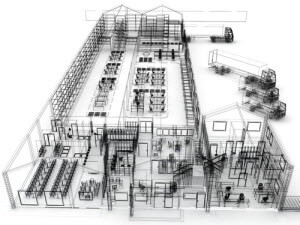How to Design a Cost-Effective Warehouse: Optimizing Your Warehouse Layout Design
While the economy and industry trends are important, nothing plays a bigger role in ensuring warehouse operation success than layout and design. With a well-designed warehouse, your facility can become more cost-effective and productive.
Here are a few tips to help you optimize your warehouse layout design.
Plan for Expansions
According to Cisco-Eagle , it’s always better to have future capacity and not need it than need the extra capacity but not have it. Simply put, you always want to make sure that your warehouse can accommodate for any potential future short- or long-term expansions.
, it’s always better to have future capacity and not need it than need the extra capacity but not have it. Simply put, you always want to make sure that your warehouse can accommodate for any potential future short- or long-term expansions.
So plan ahead. Make sure that you design the layout of your warehouse to cater to any unexpected shifts in business, inventory, or process changes. For example, you may want to have extra space within your facility just in case you need to store more product or parts.
A good way to ensure that you have extra space is to install taller pallet racks or a mezzanine with more weight capabilities than what’s currently needed. This will help you to avoid costly expansion expenses in the future.
Make and Follow Process Maps
Assess how your warehouse works on a day-to-day basis. Are there any parts in the layout that are causing bottlenecks and slow production? If so, you need to optimize the layout of your warehouse to ensure smooth and efficient workflows.
Make a process map that details how your facility currently runs and where each zone is located. Then pick out the areas that need to be changed.

Next, create a new process map with the layout changes made. For example, if you noticed a bottleneck in production and packing, the new process map may have the packing zone moved so it can easily meet the demands of production.
Ensure That Each Zone Has the Right Equipment
Each zone of your warehouse must have the right equipment and capacity to ensure that the facility runs as smoothly and efficiently as possible. So before you start optimizing the design of the warehouse, make sure that each zone features the proper systems for operation.
You also want to make sure that each system and tool is working. Run tests and diagnostics to spot any issues and have problematic systems repaired or replaced as soon as possible to avoid catastrophic and costly failures.
Accommodate for Inbound and Outbound Shipments
Above all, analyze the number of shipments and how they’re going in and out of your warehouse and accommodate the layout to them. Try implementing a clear pick path to help workers ship products to consumers faster and easier.
Also consider your warehouse’s dock capacity. The dock must have enough capacity to cater to everything that’s being shipped to the warehouse. Facilities with insufficient dock capacities may experience severe decreases in operations as well as loss of revenue.
Having a well-designed warehouse is one of the biggest factors to a business’ success. A warehouse that’s properly laid out helps to increase productivity and reduce operation costs. So consult this guide and take the steps needed to optimize your warehouse.
Contact CPV Manufacturing to learn more about the valves, fittings, and other products you may need to optimize your warehouse.
